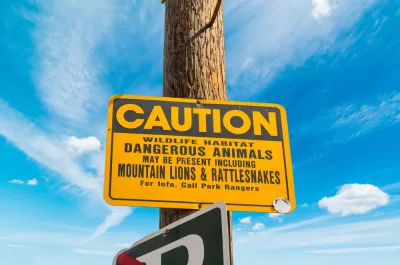The Los Angeles City Planning Commission recently approved a new Wildlife Ordinance. The City Council will make the final decision about the ordinance’s approval.

The Los Angeles City Planning Commission (CPC) approved a new Wildlife Ordinance earlier this month, according to an email to Planetizen from the Los Angeles Department of City Planning.
The draft ordinance proposes development standards for lot coverage, floor area, grading, and height limitations, and as well as native landscaping/trees, fence, trash enclosure, window and lighting requirements, according to the email. The draft ordinance makes the case that these zoning changes are necessary to fight climate change and protect biodiversity. The new zoning rules would be implemented in a new Wildlife Supplemental Use District (WLD) added to the city’s zoning map by the ordinance.
The Los Angeles Daily News covered the Wildlife Ordinance over the summer, while the current version of the ordinance was open for public comment. “The proposed Wildlife District would directly impact hilly communities in the Hollywood Hills, Hollywood, Bel Air, Beverly Crest, Laurel Canyon, Sherman Oaks and Studio City. The southern border of the proposed district follows a stair-stepping line just north of Franklin Avenue, Hollywood Boulevard, Sunset Boulevard and smaller streets in Beverly Hills,” according to that article. The Los Angeles Times Editorial Board also chimed in on the issue in November, supporting the idea of making space for animals and biodiversity in the residential neighborhoods of Los Angeles adjacent to wild and open spaces.
The vote came just a few days before the death of P-22, the city’s fabled mountain lion resident, credited with birthing and building a wildlife protection movement in the nation’s second most populous city. Alissa Walker has written an article describing the tragic and compelling story of P-22’s life in the wild parts of Los Angeles.
The CPC vote brings a planning process launched in 2016 with the Wildlife Pilot Study a critical step closer to completion. The Los Angeles City Council must still approve the ordinance for adoption.
FULL STORY: Wildlife Pilot Study

Alabama: Trump Terminates Settlements for Black Communities Harmed By Raw Sewage
Trump deemed the landmark civil rights agreement “illegal DEI and environmental justice policy.”

Study: Maui’s Plan to Convert Vacation Rentals to Long-Term Housing Could Cause Nearly $1 Billion Economic Loss
The plan would reduce visitor accommodation by 25% resulting in 1,900 jobs lost.

Why Should We Subsidize Public Transportation?
Many public transit agencies face financial stress due to rising costs, declining fare revenue, and declining subsidies. Transit advocates must provide a strong business case for increasing public transit funding.

Paris Bike Boom Leads to Steep Drop in Air Pollution
The French city’s air quality has improved dramatically in the past 20 years, coinciding with a growth in cycling.

Why Housing Costs More to Build in California Than in Texas
Hard costs like labor and materials combined with ‘soft’ costs such as permitting make building in the San Francisco Bay Area almost three times as costly as in Texas cities.

San Diego County Sees a Rise in Urban Coyotes
San Diego County experiences a rise in urban coyotes, as sightings become prevalent throughout its urban neighbourhoods and surrounding areas.
Urban Design for Planners 1: Software Tools
This six-course series explores essential urban design concepts using open source software and equips planners with the tools they need to participate fully in the urban design process.
Planning for Universal Design
Learn the tools for implementing Universal Design in planning regulations.
Smith Gee Studio
Alamo Area Metropolitan Planning Organization
City of Santa Clarita
Institute for Housing and Urban Development Studies (IHS)
City of Grandview
Harvard GSD Executive Education
Toledo-Lucas County Plan Commissions
Salt Lake City
NYU Wagner Graduate School of Public Service





























